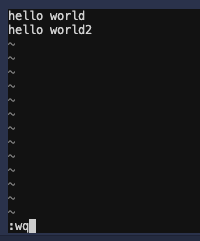What is Ansible Vault
Ansible Vault is an encryption feature of Ansible. It allows you to encrypt sensitive information that you don't want to register as is in Git.
How to use Ansible Vault
Installation
To use Ansible Vault, you need to install Ansible, which can be easily done with the brew command on a Mac.
$ brew install ansible
encrypt
You can encrypt files with the ansible-vault encrypt command.
Suppose you have the following sample.txt.
hello world
Encrypt this file. Execute the following command. You will be prompted for a password when executing it.
$ ansible-vault encrypt sample.txt
New Vault password:
Confirm New Vault password:
Encryption successful
You can see that sample.txt is encrypted.
$ cat sample.txt
$ANSIBLE_VAULT;1.1;AES256
35346464303934323662376134353665626366656530306435343563613639356661303032613531
3538363133366661366132653661383763313564303435610a353037323661373237376565626163
38666534616566343862396233373138323466376332383334626637313365666332626165613263
3938343333313936360a393865313834326439613332316238383735663738363639626538623432
3039
view
You can use the ansible-vault view command to see the contents of the encrypted files.
The sample.txt is encrypted as follows.
$ANSIBLE_VAULT;1.1;AES256
35346464303934323662376134353665626366656530306435343563613639356661303032613531
3538363133366661366132653661383763313564303435610a353037323661373237376565626163
38666534616566343862396233373138323466376332383334626637313365666332626165613263
3938343333313936360a393865313834326439613332316238383735663738363639626538623432
3039
Check the contents of the file with the following command.
$ ansible-vault view sample.txt
Vault password:
hello world
decrypt
You can decrypt encrypted files with the ansible-vault decrypt command.
The sample.txt is encrypted as follows.
$ANSIBLE_VAULT;1.1;AES256
35346464303934323662376134353665626366656530306435343563613639356661303032613531
3538363133366661366132653661383763313564303435610a353037323661373237376565626163
38666534616566343862396233373138323466376332383334626637313365666332626165613263
3938343333313936360a393865313834326439613332316238383735663738363639626538623432
3039
Decrypt the file with the following command.
$ ansible-vault decrypt sample.txt
Vault password:
Decryption successful
If you check the contents of sample.txt, you will see that it has been decrypted.
$ cat sample.txt
hello world
edit
You can edit encrypted files with the ansible-vault edit command.
The sample.txt is encrypted as follows.
$ANSIBLE_VAULT;1.1;AES256
35346464303934323662376134353665626366656530306435343563613639356661303032613531
3538363133366661366132653661383763313564303435610a353037323661373237376565626163
38666534616566343862396233373138323466376332383334626637313365666332626165613263
3938343333313936360a393865313834326439613332316238383735663738363639626538623432
3039
Edit the file with the following command.
$ ansible-vault edit sample.txt
The edit screen will appear as follows.

Let us add hello world2. To finish editing, type :wq and press Enter.

The sample.txt will be updated as follows.
$ANSIBLE_VAULT;1.1;AES256
66643539663734313236383233323632396332386435343338643133316265633866356334373735
3434633866386133633337616366653831653130396237660a303362613461316666626534633039
31653665613166646431343761663030336432626237646439356435383263343863353562363535
6362336435386564620a633761366435653261636231303962376464343438333635306666316634
62656237363533613930366164643534613036376165626235306230396538313232
rekey
You can change the encryption password with the ansible-vault rekey command.
$ ansible-vault rekey sample.txt
Vault password:
New Vault password:
Confirm New Vault password:
Rekey successful
encrypt_string
The ansible-vault encrypt_string command allows you to encrypt only specific values in a file.
Suppose you have the following sample.yml file.
ansible_user: admin
ansible_password: Passw0rd
Run the following command to encrypt the Passw0rd in the sample.yml file.
$ ansible-vault encrypt_string 'Passw0rd' --name 'ansible_passowrd'
New Vault password:
Confirm New Vault password:
Encryption successful
ansible_passowrd: !vault |
$ANSIBLE_VAULT;1.1;AES256
61666133633537333166386335396662623163636437346438353039323461346439343463663337
3037633263366231316336313831356230656266646536380a303965613565336461313931386634
30616131653230356666396239386561613166393730353261363963393465386338663733386231
3663343932656539300a666234353464643632646661326339653438613631303338363530653166
3563
At this time, nothing changes in sample.yml. Manually replace Passw0rd in sample.yml as follows.
$ cat sample.yml
ansible_user: admin
ansible_passowrd: !vault |
$ANSIBLE_VAULT;1.1;AES256
61666133633537333166386335396662623163636437346438353039323461346439343463663337
3037633263366231316336313831356230656266646536380a303965613565336461313931386634
30616131653230356666396239386561613166393730353261363963393465386338663733386231
3663343932656539300a666234353464643632646661326339653438613631303338363530653166
3563
You can decrypt the value by executing the following command.
$ echo '$ANSIBLE_VAULT;1.1;AES256
61666133633537333166386335396662623163636437346438353039323461346439343463663337
3037633263366231316336313831356230656266646536380a303965613565336461313931386634
30616131653230356666396239386561613166393730353261363963393465386338663733386231
3663343932656539300a666234353464643632646661326339653438613631303338363530653166
3563' | ansible-vault decrypt
Vault password:
Decryption successful
Passw0rd
--vault-password-file
You can specify a password file with the --vault-password-file option.
Suppose you have the following pw_file.
mypassword
You can encrypt sample.txt by specifying pw_file as the password file with the following command.
$ ansible-vault encrypt --vault-password-file pw_file sample.txt
--vault-id
Ansible Vault allows multiple passwords.
The --vault-id label@source option specifies the Vault identifier and password file. For example, the command would look like this.
$ ansible-vault encrypt --vault-id password1@pw_file sample.txt
--output
The --output option allows you to specify the output destination for the generated files.
$ ansible-vault encrypt --output dir/sample.txt.vault sample.txt
$ ansible-vault decrypt --output sample.txt dir/sample.txt.vault
References